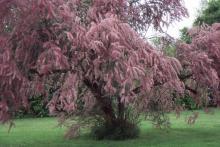Tamarix parviflora
Common name:
Small-flowered Tamarix
Salt Cedar
Pronunciation:
TAM-a-riks par-vi-FLO-ra
Family:
Tamaricaceae
Genus:
Type:
Broadleaf
Native to (or naturalized in) Oregon:
No
- Deciduous tree/shrub, 12-15 ft (3.5-4,5 m); sprawly, twiggy. Leaves alternate, simple, lanceolate, scale-like, 3 mm long (similar to juniper foliage). Flowers very small (parviflora = small flowered), light pink, 4-parted, in 3-4 cm long clusters, bloom in spring.
- Sun, well-drained soil; develops a deep tap root and is drought tolerant. Should be pruned hard after bloom to maintain graceful appearance. Can be propagated by sticking a cutting in the ground at the beginning of winter.
- Hardy to USDA Zone 4 Native to southeastern Europe
- Occasionally used in bonsai
- There is confusion in labeling tamarisks in nurseries. It is difficult to separate T. parviflora from T. tetranda, both are spring flowering.
- parviflora: having small flowers
- Tamarisks are known as Salt Cedars, especially the summer-flowering T. chinensis (formerly T. pentanda, some also include T. ramosissima in this species). Some species have naturalized over much of the western US, the greatest infestations occur in Texas, Arizona, Utah, New Mexico, and Oklahoma. Tamarisks grow primarily in areas where its roots can reach ground water and the plant can tolerate saline conditions by exuding salt from its leaves. They reduce biological diversity by replacing native riparian vegetation (Randall and Marinelle, 1996).









